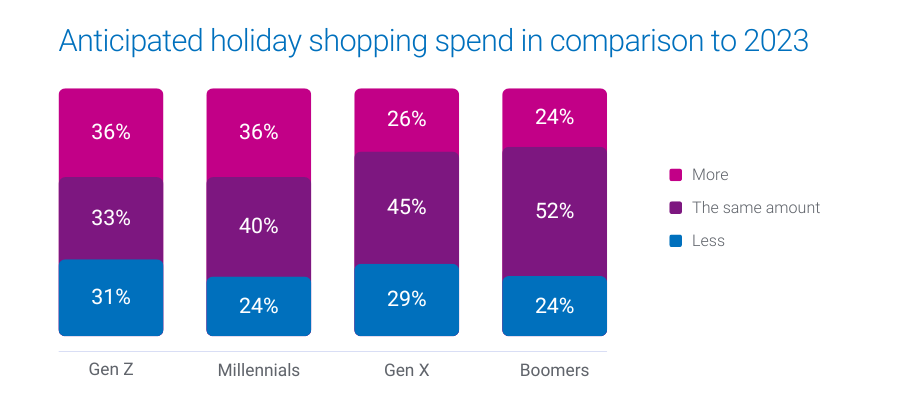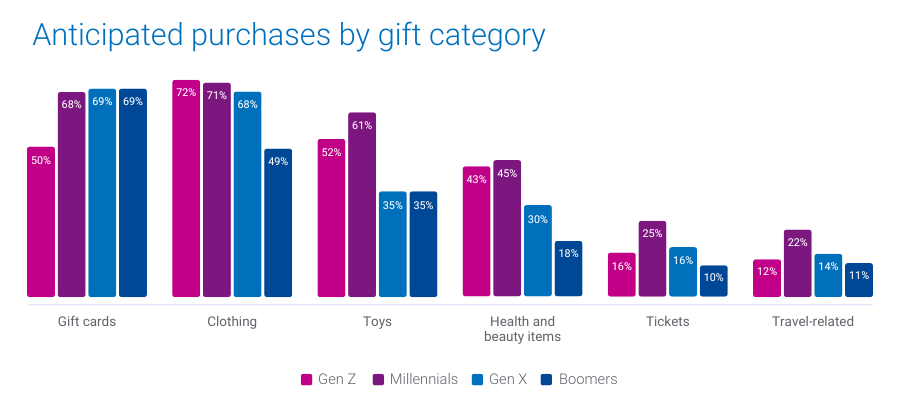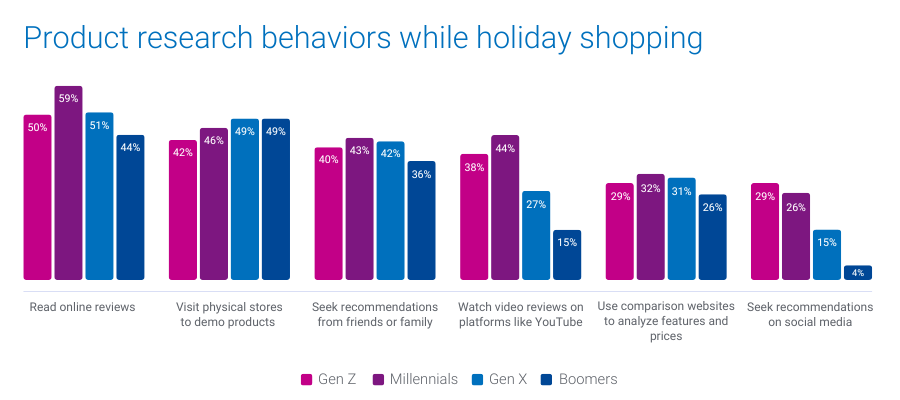
The holiday season is almost here, and knowing how each generation plans to shop can give your holiday advertising campaigns the edge you need. Our recent survey of 1,000 U.S. consumers reveals 2024 holiday shopping trends for each generation and key insights into their anticipated spending levels, preferred shopping categories, and how they look for gift ideas.
In this blog post, we’ll explore three 2024 holiday shopping trends across generations:
- Projected consumer spending
- Top categories on shoppers’ lists
- Preferred channels for researching gifts
1. Projected consumer spending
Over 1 in 3 Gen Z and Millennials are gearing up to increase their holiday budgets this year, while Gen X and Boomers are likelier to stick to last year’s budget.
- 36% of Millennials and Gen Z plan to spend more this holiday season
- 45% of Gen X and 52% of Boomers expect their spending to remain consistent with last year

What this means for marketers
These insights highlight the importance of tailoring your messaging. For Gen Z and Millennials, emphasize value and unique offerings that justify increased spending. For Gen X and Boomers, focus on trust and reliability, reinforcing their confidence in your brand.
How Experian can help you target these audiences
Experian’s custom and syndicated audience segments, including Holiday Shopper High Spenders and Holiday Shopper Moderate Spenders, enable you to connect with these diverse consumer groups. Our audiences are available on-the-shelf of leading ad platforms to help you reach people across social, TV, and mobile.
The election effect
U.S. holiday retail sales saw 4.1% YoY growth in 2016 and 8.3% YoY growth in 2020 following presidential elections. There’s a chance that holiday spending increases after the 2024 election, regardless of the outcome. Experian has 240+ politically relevant audiences that you can activate across major ad platforms ahead of the upcoming election.
2. Top categories on shoppers’ lists
Different generations have distinct preferences when it comes to what they plan to buy. Gift cards top the list for Gen X and Boomers, while Gen Z leans toward clothing. Millennials are looking to splurge on toys, electronics, and experiences.
- 69% of Boomers and Gen X plan to purchase gift cards
- 72% of Gen Z will buy clothing
- 45% of Millennials will buy health and beauty items
- 25% of Millennials will buy tickets and 22% of Millennials will buy experiences

What this means for marketers
Align your product offerings and promotions with each generation’s preferences to capture their attention. For example, highlighting versatile gift cards may resonate more with older generations, while showcasing trendy apparel and tech gadgets will appeal to younger consumers.
How Experian can help you target these shoppers
We offer audience segments like Holiday Shoppers: Apparel, Cosmetics & Beauty Spenders, and Toys Shoppers that you can activate to connect with consumers primed to purchase in these categories.
We recently released 19 new holiday shopping audiences we recommend targeting to drive engagement and conversions. Download our audience recommendations here.
3. Preferred channels for researching gift ideas
When it comes to finding the perfect gifts, Gen Z turns to social media, while Millennials prefer online reviews and video content. Boomers and Gen X are more inclined to visit physical stores for hands-on product evaluations.
- 29% of Gen Z and 26% of Millennials will look for gift ideas on social media
- 44% of Millennials will rely on video reviews and product demos on platforms like YouTube
- 49% of Gen X and Boomers plan to visit physical stores to evaluate products in person

What this means for marketers
Understanding where each generation looks for inspiration can guide your content and ad placement strategy. To engage Gen Z, focus on social media campaigns and influencer partnerships. For Millennials, consider investing in video content and reviews. For older generations, ensure your in-store experience is optimized to convert browsing into purchases.
How Experian can help you engage these shoppers
Our TrueTouchTM audiences can help you pair the perfect messaging styles with the right channels and calls to action. Our Social media channel and content engagement audiences can help you reach Gen Z who are likely to be active users on major social platforms and are Black Friday shoppers. For a full list of Experian’s syndicated audiences and activation destinations, download our syndicated audiences guide.
Download our report for five 2024 holiday shopping trends by generation
Understanding 2024 holiday shopping trends by generation can help you tailor your targeting, messaging, media planning, and creative based on the generation you’re targeting.
In addition to the insights covered here, download our 2024 Holiday spending trends and insights report to learn:
- When consumers plan to shop (hint: they’re already shopping)
- Where they plan to shop (online vs. in-store)
Download our full report to access all five of our predictions by generation, so you can address the diverse needs of this year’s holiday shoppers.
When you work with Experian for your holiday shopping campaigns, you’re getting:
- Accurate consumer insights: Better understand your customers’ behavioral and demographic attributes with our #1 ranked data covering the full U.S. population.
- Signal-agnostic identity solutions: Our deep understanding of people in the offline and digital worlds provides you with a persistent linkage of personally identifiable information (PII) data and digital IDs, ensuring you accurate cross-device targeting, addressability and measurement.
- Secure connectivity: Bring data and identity to life in a way that meets your needs by securely sharing data between partners, utilizing the integrations we have across the ecosystem, and using our marketing data in flexible ways.
Make the most of this holiday shopping season with Experian. Contact us today to get started.
Source
Online survey conducted in June, 2024 among n=1,000 U.S. adults 18+. Sample balanced to look like the general population on key demographics (age, gender, household income, ethnicity, and region).
Latest posts

Published in AdExchanger. “Data-Driven Thinking" is written by members of the media community and contains fresh ideas on the digital revolution in media. Today’s column is written by Tom Manvydas, vice president of advertising strategy and solutions at Experian Marketing Services. The proliferation of connected electronics has spurred new interest in device-recognition technologies even though they have been in use since the 1990s. As we enter the “Internet of Things” era, device recognition will significantly impact the ad tech ecosystem. Many network advertising technologies are becoming obsolete as cookie blocking grows and the Internet becomes more mobile and device-centric. Device recognition will be yet another technology challenge for marketers but has the potential to overcome many key tracking, measurement and privacy issues with which data-driven marketers have struggled. By leveraging device recognition technologies, marketers can protect their investments in Web 2.0 ad tech, like multitouch attribution, and improve their overall digital marketing programs. Device Recognition Vs. Cookies Device recognition attempts to assign uniqueness to connected devices. By focusing on the device, you are able to “bridge” between browsers and apps, desktop to mobile and across OS platforms like iOS and Android. Device-recognition IDs function like desktop cookies for devices but with four important differences: 1. Coverage: Device-recognition methods are largely immune from cookie limitations. About half of mobile engagements on the Web do not involve cookies, while third-party blocking impacts up to 40% of desktop engagements. 2. Persistency: Device-recognition IDs can be more persistent and less fragmented than most desktop cookies. For example, Apple’s UDID or Android ID are permanent, and network node IDs like MAC addresses are near-permanent. Proxy IDs such as IDFA are persistent but can be updated by the device owner or ID provider. 3. Uniqueness: Devices are unique and cookies are fragmented. The digital media industry incurs substantial overhead cost and loss of efficiency when dealing with fragmented profiles and obsolete data caused by cookie churn. However, device-recognition methods are limited in their ability to recognize multiple profiles on shared devices. 4. Universality: Device-recognition technologies are universal and generally work across devices and networks. However, interoperability issues across device operating systems, such as iOS and Android, can limit the universal concept. There are many types of device-recognition technologies but two basic approaches to device recognition: deterministic and probabilistic, each with their pros and cons. Deterministic Approach: Accurate And Persistent But Complicated Deterministic device recognition primarily uses the collection of various IDs. While the mobile developer is familiar with the variety of IDs, it’s important that marketers become better-versed in this area. Examples include hardware IDs (including serial numbers), software-based device IDs (such as Apple’s UDID or the Android ID), digital data packet postal codes or proxy IDs (such as MAC addresses for WiFi or Bluetooth, IDFA for both iOS and Android and open-source IDs). Deterministic methods improve the accuracy of tracking, targeting and measurement over current cookie-based methods. They can improve the ability to more persistently manage consumer opt-outs. But the proliferation of device types limits the universality of deterministic device recognition. Without uniform standards across platforms, marketers need to account for multiple ID types. Also, deterministic device-recognition methods are not well developed for desktop marketing applications. The lack of interoperability across deterministic device IDs makes execution too complicated. Deterministic device IDs were meant for well-intentioned uses, such as tracking the carrier billing for a device. However, they present privacy and data rights challenges, leading to blocking or limited access by companies that control IDs. Probabilistic Device Recognition: A ‘Goldilocks’ Solution Probabilistic device recognition may be the ideal solution for a connected world that does not rely on cookies nor wants to use overly intrusive deterministic device recognition. Probabilistic device recognition is not a replacement for deterministic IDs. Instead, it complements their function and provides coverage when they are not available. The probabilistic approach is based on a statistical probability of uniqueness for any single device profile. This approach creates a unique profile based on a large number of common parameters, such as screen resolution, device type and operating system. This process can uniquely identify a device profile with 60% to 90% accuracy, compared to 20% to 85% accuracy for cookie-based identification methods. Probabilistic IDs are more persistent than cookies with better coverage, but less persistent than deterministic device IDs. The natural evolution of the device takes place over time and prevents persistent identification. Probabilistic device recognition can be universal and is not impacted by interoperability issues across platforms — the technology used to generate a probabilistic ID on one network can be the same technology on another network. Unlike some deterministic device recognition approaches, there is no device fingerprinting. Probabilistic device recognition accurately identifies profiles in aggregate, rather than a single device. That’s the inherent beauty of probabilistic device recognition: It can generate more accurate targeting results than cookie-based methods without explicitly identifying single devices. This is more than good enough for most marketers and significantly better than what’s available today. Another benefit is the absence of any residue on the device — no cookie files, flash files or hidden markers. Probabilistic methods can work on devices that block third-party cookies or connect to the Web without using any cookies. For example, you might have a hard-to-reach but valuable audience segment. Probabilistic device recognition could effectively increase your reach on this segment by 40% to 50% and increase the overall targeting accuracy by two times. Let’s say the actual population for this segment is 100,000 members. The typical cookie-based approach might reach 28,000 members but the typical probabilistic device-recognition approach could reach 65,000 members. A Decline In Hardware Entropy If you take a close look at the emitted data from today’s devices, it is not easy to analyze it for device identification. That’s because the data footprint of one device looks a lot like another. Device recognition augmentation methods can address this, such as device usage profiles, geo location clustering, cross-device/screen analytics or ID linkage for first-party data owners. In the short term, device-recognition technologies, particularly probabilistic methods, can greatly improve today’s digital marketing programs. Marketers should become fluent in their use cases and benefits. If 2013 was the year of mobile, I think we’ll see a surge in marketing applications based on device-recognition technologies in 2014. Follow Experian Marketing Services (@ExperianMkt) and AdExchanger (@adexchanger) on Twitter.

According to Experian Marketing Services’ 2014 Digital Marketer: Benchmark and Trend Report, social media Websites are playing an increasingly important role in driving traffic to other Websites, including retail sites and even other social networking sites, at the expense of search engines and portal pages. For instance, as of March 2014, social media sites account for 7.72 percent of all traffic to retail Websites, up from 6.59 percent in March 2013. Further, Pinterest, more than Facebook or YouTube, is supplying the greatest percentage of downstream traffic to retail sites. According to the Digital Marketer Report, more retailers are directing their customers to social media within their email campaigns. In fact, 96 percent of marketers now promote social media in their emails, and it shows. In 2013, for instance, email Websites generated 18 percent more clicks to social networking pages than the year prior. Social drives more traffic to other social Websites Social media Websites are driving more and more traffic to other social sites. In 2013, 15.1 percent of clicks to social networking and forum sites came from other social networking sites, up from a 12.5 percent click share reported in 2012. Despite driving the greatest share of traffic to social networking sites with 39.1 percent of clicks, search engines’ share of upstream traffic to social declined a relative 13 percent year-over-year. Among the other top referring industries to social, only the portal front pages industry — which includes sites like Yahoo!, MSN and AOL and is closely affiliated with search engines — showed a drop in upstream click share providing further evidence that increasingly all (or most) roads lead to social. To learn more about key trends in social media traffic, including downstream traffic from social sites and the share of consumers accessing social media across multiple channels, download the free 2014 Digital Marketer: Benchmark and Trend Report.

Mother’s Day may not exactly be right around the corner, but the time to send your Mother’s Day emails sure is! Based on our analysis of 186 brands that sent Mother’s Day mailings in 2013, 75 percent of email volume and 80 percent of email-generated revenue occurred between May 1st and Mother’s Day (May 12, 2013). The highest revenue-producing days were five days before the holiday (Wednesday, May 8, 2013) and Mother’s Day itself. This year, the sentimental holiday falls one day sooner than last year (May 11), but you still have more than enough time consider these quick tips for easy wins while planning and executing your campaigns. Tip 1: Give them what they’re searching for Last year, online searches five weeks before Mother’s Day were dominated by searches for the date of the holiday. As such, we recommend including the date of Mother’s Day in your email subject lines, particularly those early in the season, when customers are searching online for, and opening emails with, that information. Tip 2: Set the tone early with your subject lines A sample of early season subject lines that outperformed the overall unique open rate included: Remember Mom on Mother’s Day, May 12 Get a head start on Mother’s Day (plus a gift for you) Just arrived: Mother’s Day Gift Sets To Mother, With Love Tip 3: When it comes to timing, it’s the thought that counts Think through the timing of your emails depending on order delivery deadlines. On May 8th of last year, the largest revenue producers for email were orders for flowers and gifts placed in time to be delivered by Mother’s Day. Email subject lines on May 8th included reminders of the delivery deadlines: Last Chance: Free Shipping/No Service Charge for Mother’s Day! ENDS TODAY: Enjoy Complimentary Second Day Delivery in Time for Mother’s Day Tip 4: Let them treat themselves On Mother’s Day, the top email revenue generators were “self-gifting” (treat yourself on Mother’s Day only), Mother’s Day online sales and free shipping, as well as e-gift cards: Free Shipping Today Only! Happy Mother’s Day You deserve a treat yourself! HAPPY MOTHER’S DAY! Treat yourself to 30% off today only Last Chance: eGift Cards in Time for Mother’s Day Other email performance highlights: Note: All email performance highlights are based on comparisons to Mother’s Day mailings without the highlighted feature from matched brands. To all those in the midst of Mother’s Day campaign planning, good luck and happy sending!